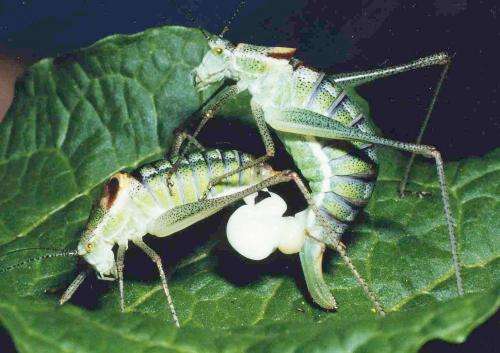Male bushcrickets are in charge when it comes to sex

All a question of timing: When bushcrickets mate, the male attaches a sticky package, the so-called spermatophore, to the female's abdomen. Alongside the sperm themselves, this 'bridal present' consists of a protein-rich mass that the female eats after mating. It then takes several hours for the sperm to find their way into the female's reproductive tract. But, who decides when that will happen? A study by the Bielefeld biologists Professor Dr. Klaus Reinhold and Dr. Steven Ramm suggests that it is the male who determines the dynamics of this process even when he has long 'hopped off' somewhere else. They have now published their results in the online first version of the journal Behavioural Ecology and Sociobiology.
In contrast to direct sperm transfer, the use of a spermatophore could grant the female more influence over the fertilization or non-fertilization of her eggs. However, the results of the Bielefeld study cast doubt on this assumption. They suggest a high degree of male control over this decisive stage in reproduction. For their study, Professor Dr. Klaus Reinhold and Dr. Steven Ramm from Bielefeld University paired males and females from two subspecies of the bushcricket Poecilimon veluchianus in whom the time between pairing and sperm transfer differ. Whereas in the subspecies Poecilimon veluchianus minor, sperm are transferred within the first three hours, the transfer in Poecilimon veluchianus veluchianus starts only after four hours. If the two subspecies are interbred – the researchers thought – then the number of transferred sperm after three hours would indicate whether it is the male or the female who determines how long this transfer takes.
The researchers mated nine to twelve pairs in each of the four possible combinations of Poecilimon veluchianus minor and Poecilimon veluchianus veluchianus. Three hours after mating, they examined how many sperm they could find in the female's reproductive tract. The result: the sperm from the males of the 'faster' subspecies Poecilimon veluchianus minor could be found in the females of both subspecies. In contrast, the males in the 'slower' sub-species Poecilimon veluchianus veluchianus had transferred almost no sperm at all to either type of female.
The researchers conclude from this experiment that the males control the speed of transfer over the sperm package. However, this does not automatically lead to the conclusion that the female is powerless. Females can also influence whether sperms are transferred by how quickly they eat the spermatophore. In addition, the larger the male, the larger the size of the sperm package, and this influences how long the females need to consume the protein. As a result, the sperm have more time to transfer to the female – and the female's eggs have a greater chance of being fertilized by a 'high-quality' male. Professor Reinhold stresses, 'Our findings show that the females do not determine the transfer – not that they could not do so.'
More information: link.springer.com/article/10.1007%2Fs00265-012-1459-4
Journal information: Behavioural Ecology and Sociobiology
Provided by University of Bielefeld


















